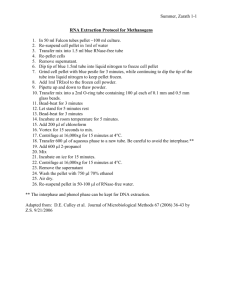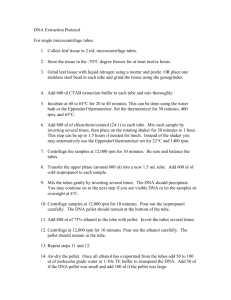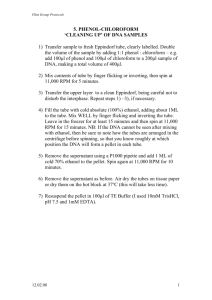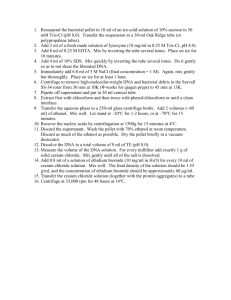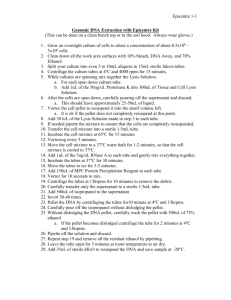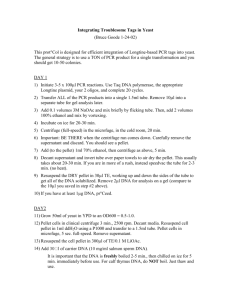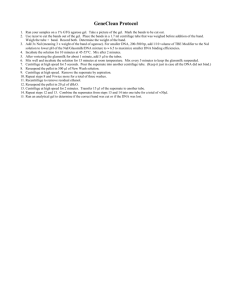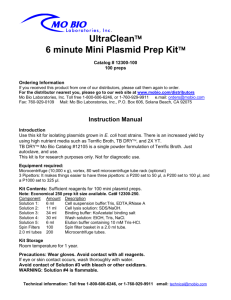Cesium chloride
advertisement
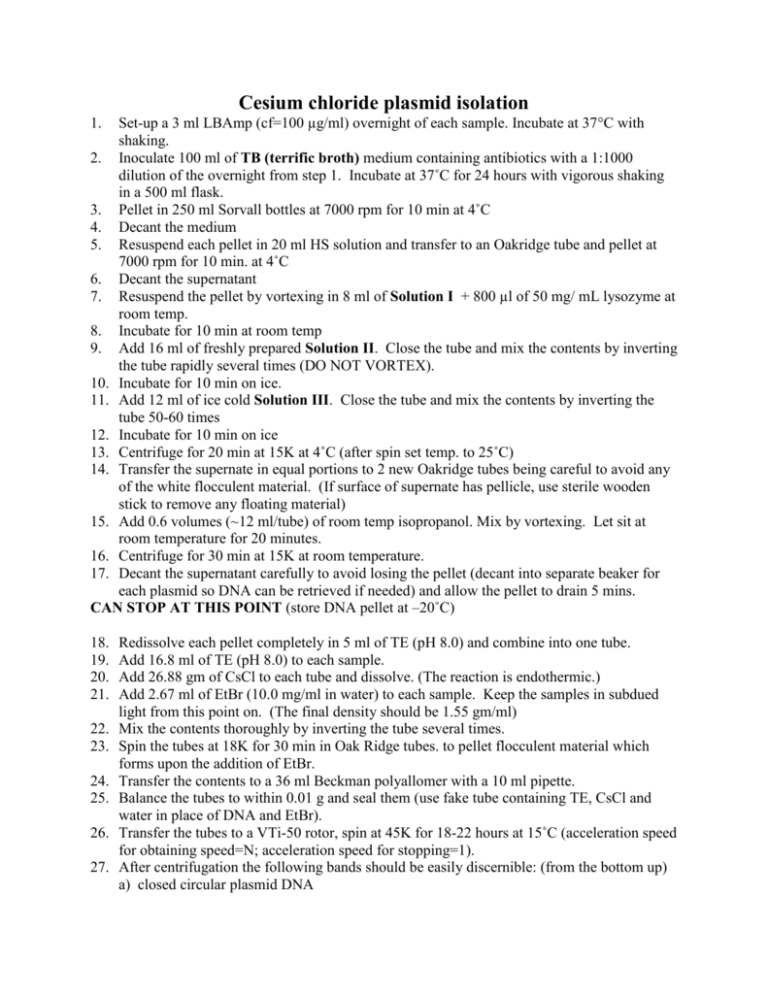
Cesium chloride plasmid isolation 1. Set-up a 3 ml LBAmp (cf=100 µg/ml) overnight of each sample. Incubate at 37C with shaking. 2. Inoculate 100 ml of TB (terrific broth) medium containing antibiotics with a 1:1000 dilution of the overnight from step 1. Incubate at 37˚C for 24 hours with vigorous shaking in a 500 ml flask. 3. Pellet in 250 ml Sorvall bottles at 7000 rpm for 10 min at 4˚C 4. Decant the medium 5. Resuspend each pellet in 20 ml HS solution and transfer to an Oakridge tube and pellet at 7000 rpm for 10 min. at 4˚C 6. Decant the supernatant 7. Resuspend the pellet by vortexing in 8 ml of Solution I + 800 µl of 50 mg/ mL lysozyme at room temp. 8. Incubate for 10 min at room temp 9. Add 16 ml of freshly prepared Solution II. Close the tube and mix the contents by inverting the tube rapidly several times (DO NOT VORTEX). 10. Incubate for 10 min on ice. 11. Add 12 ml of ice cold Solution III. Close the tube and mix the contents by inverting the tube 50-60 times 12. Incubate for 10 min on ice 13. Centrifuge for 20 min at 15K at 4˚C (after spin set temp. to 25˚C) 14. Transfer the supernate in equal portions to 2 new Oakridge tubes being careful to avoid any of the white flocculent material. (If surface of supernate has pellicle, use sterile wooden stick to remove any floating material) 15. Add 0.6 volumes (~12 ml/tube) of room temp isopropanol. Mix by vortexing. Let sit at room temperature for 20 minutes. 16. Centrifuge for 30 min at 15K at room temperature. 17. Decant the supernatant carefully to avoid losing the pellet (decant into separate beaker for each plasmid so DNA can be retrieved if needed) and allow the pellet to drain 5 mins. CAN STOP AT THIS POINT (store DNA pellet at –20˚C) 18. 19. 20. 21. 22. 23. 24. 25. 26. 27. Redissolve each pellet completely in 5 ml of TE (pH 8.0) and combine into one tube. Add 16.8 ml of TE (pH 8.0) to each sample. Add 26.88 gm of CsCl to each tube and dissolve. (The reaction is endothermic.) Add 2.67 ml of EtBr (10.0 mg/ml in water) to each sample. Keep the samples in subdued light from this point on. (The final density should be 1.55 gm/ml) Mix the contents thoroughly by inverting the tube several times. Spin the tubes at 18K for 30 min in Oak Ridge tubes. to pellet flocculent material which forms upon the addition of EtBr. Transfer the contents to a 36 ml Beckman polyallomer with a 10 ml pipette. Balance the tubes to within 0.01 g and seal them (use fake tube containing TE, CsCl and water in place of DNA and EtBr). Transfer the tubes to a VTi-50 rotor, spin at 45K for 18-22 hours at 15˚C (acceleration speed for obtaining speed=N; acceleration speed for stopping=1). After centrifugation the following bands should be easily discernible: (from the bottom up) a) closed circular plasmid DNA 28. 29. 30. 31. b) nicked plasmid DNA / linear DNA The closed circular DNA is collected from the centrifuge tube by puncturing the tube with a 10cc syringe (fitted with an 18 gage needle), just below the plasmid DNA band (remember to unseal the centrifuge tube) and withdrawing the band slowly into the syringe. For better visualization of the various bands the collection may be carried out under longwave UV light. Ethidium bromide (EtBr) is removed from the DNA by extracting 6 times with an equal volume of H2O saturated n-butyl alcohol (or until pink color is gone). This is done in the same syringe that was used to remove the plasmid band from the centrifuge tube. The plasmid samples are then dialyzed vs. four changes of TE buffer, pH 8.0 [3X 1 hour/change then 1 change overnight at 4°C] and then precipitated by addition of 0.1 vol of 3 M NaOAc and 2.0 vol of EtOH. Incubate on ice for 30 min or overnight at –20˚C. The precipitate is collected by centrifugation at 15K rpm at 30˚C for 30 min. The pellet is redissolved in 1 ml of TE, pH 8.0, and quantitated by A260 measurement and analyzed by agarose gel electrophoresis Solutions: TB (Terrific Broth): Solution I: For 900 ml 12 g bacto-tryptone 24 g bacto-yeast extract 4 ml glycerol QS to 900 ml Solution II: For 100 ml 2.31 g KH2PO4 (Cf = 0.17 M) 12.54 g K2HPO4 (Cf = 0.72 M) QS to 100 ml Solution I: 50 mM glucose 10 mM EDTA 25 mM Tris-HCl (pH 8.0) 5 mg/ml lysozyme (added just prior to use) Solution II: 0.2 N NaOH 1% SDS Solution III: (the solution is 3M with respect to potassium and 5M with respect to acetate) 60 ml 5M Potassium acetate 11.5 ml glacial acetic acid 28.5 ml diH2O TE buffer: 10 mM Tris-HCl (pH 8.0) 1 mM EDTA HS buffer: 10 mM Hepes (pH 7.3) .85% NaCl
